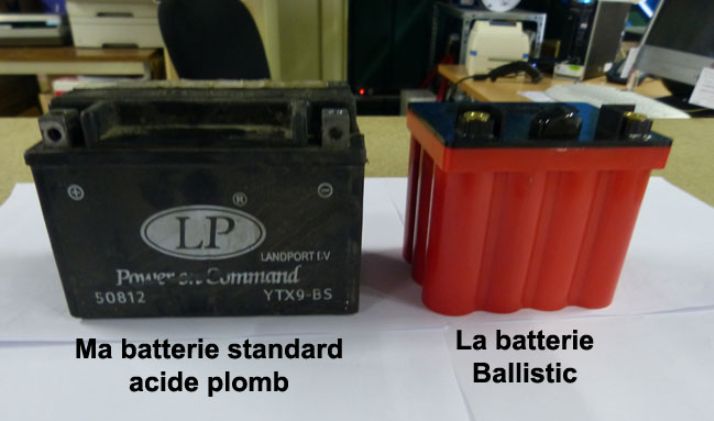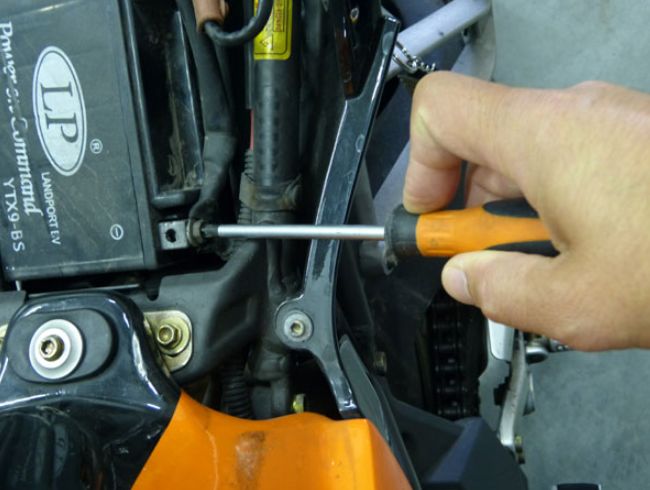
1- What's the battery for?
On your motorcycle or scooter, the charging circuit consists of the alternator and the battery. These 2 elements are linked by electrical cables. The alternator supplies current to the battery when the engine is running. If the battery is tired, it can no longer accumulate the energy supplied by the alternator, and breakdown is inevitable. I've tested it for you, and it's pretty unpleasant to push a bike. That's why it's better to be accompanied by a good girlfriend.
Anyway, the battery supplies the energy needed by the starter and other accessories on your motorcycle, such as the speedometer and fuel injection... It's an essential part of your 2-wheeler's operation.
2- How to maintain your battery
As you've probably noticed, your battery is put to the test in winter. It generally loses 1/3 of its capacity when the cold weather arrives. If your motorcycle or scooter sleeps outside and you make short trips, this will accelerate the discharge of your battery. The alternator won't have enough time to recharge your battery properly.
Voltmeter:
You can check the condition of your battery with a voltmeter. With the engine off, connect the 2 prongs of the voltmeter to the battery terminals. To help you read the results, here's a quick summary for a typical 12-volt battery:
- If the voltage is 10.5 volts, the battery is malfunctioning. It's ready for disposal.
- If the voltage is 12 volts, the battery is discharged. All you need to do is recharge it for 24 to 48 hours, depending on the charger you use. Your battery's voltage will peak at 15 volts (14.5 volts for gel batteries). It will then drop to 12.6 volts after a few hours' rest.
- If your battery's voltage is 12.6 volts, this means it's 100% charged.
Battery tester:
You can also use an electronic battery tester. Battery manufacturers offer them. The device gives you the state of your battery at a glance. I recommend the BS BT02 battery tester. At the same time, you can test the alternator.
The battery charger:
We advise you to opt for an intelligent electronic battery charger. There are 4 main reasons for this:
- It defines the charging current to be sent according to your battery's power and state of discharge: no risk of error.
- It will start maintenance as soon as your battery has reached its maximum capacity, i.e. 12.6 volts, so as not to damage it.
- It will protect your battery in the event of polarity inversion
- It is often equipped with a desulphation function to recover certain degraded batteries.
If you opt for a manual charger, set the charging current to a maximum of 10% of the battery's capacity (e.g. a 15AH battery, max. charge 1.5A). Test your battery regularly and disconnect it when it has reached 15 volts for a 12-volt battery.
In my opinion, this is an essential accessory to have in your garage.
Electrolyte level:
Batteries are normally maintenance-free, but some allow access to the electrolyte (a mixture of distilled water and sulfuric acid) via a cap. The electrolyte must be topped up with demineralized water. It's easy to find in DIY stores. The electrolyte level should be above the internal metal parts of the battery.
The condition of the terminals:
Your battery terminals should be free of any traces of oxidation. This whitish deposit is a sulfate compound that prevents the current from flowing properly. In this case, clean the terminals with a wire brush after disconnecting the motorcycle battery.
You can also use WD 40 contact cleaner. Its non-conductive, fast-evaporating formula will enable you to clean your terminals easily without disassembly.
3- When to change your battery and which one to choose?
When your battery stops charging, or can't hold a charge even though your alternator is working properly, it's time to change it. Without any major problems, a battery has a lifespan of 2 to 4 years. On some bikes, it may be shorter. On my Street Triple, for example, it was every year!
Which battery to choose?
Your motorcycle or scooter accepts only one type of battery (identical dimensions and power ratings). Please refer to the maintenance booklet supplied by the manufacturer. You can also consult our battery search engine:)
For your information, there are two types of amperage on batteries. The ah, or ampere/hour, is the power used to start the motorcycle. Amps, or amperes, is the battery's real power when used for extended periods.
At Ixtem Moto you'll find classic lead-acid batteries: BS, Nitro and Yuasa brands
and lithium batteries. We have opted for the Ballistic brand, which offers the following advantages:
- Reduced size and weight(up to 80% smaller and up to 4.5 kg lighter than standard batteries). Here's the proof! I removed the battery from my MV Agusta Brutale and compared weight and bulk.
Overall dimensions:

Weight :

- As a completely "dry" technology, batteries can be fitted in any direction. In my MV Agusta, the battery is in the prone position.
- More than twice the life of a lead-acid battery in similar conditions.
- No maintenance charger required, loses only 10% of its charge in one year of static use.
4- How to replace your battery?
The battery is probably the easiest part to replace. The hardest part is finding out where it is located on your motorcycle or scooter. Usually, the battery is under the seat, but sometimes manufacturers put it in much more exotic places.
Once you've found it, disconnect the terminals, remove the battery and install the new one. Be careful not to connect the wrong polarity (+) and (-). Remember to grease the terminals of the new battery to prevent corrosion. Grease is not conductive. I use white grease in a tube like Silkolene RENOLIT MULTIFONCTION.
Of course, please don't throw your battery away just anywhere. There's usually a recycling area at your rubbish tip, but if not, please contact a garage.
5- Our assembly and maintenance tips:
- When dismantling, always disconnect the negative terminal on the battery first, as this is connected to the motorcycle's ground. To recognize them, the negative terminal is black, while the positive terminal is red. It's that easy! All you need is a Phillips screwdriver.

- For lead-acid batteries, you need to fill the battery with acid. If acid is not supplied (this is often the case with mail-order batteries), you can find it at your local DIY store. It is advisable to charge the battery to full capacity before using it for the first time. This will extend the life of your battery.
- If you store your battery, it must be charged, otherwise it will sulphate and die prematurely.
- If your motorcycle is immobilized for more than a month, disconnect the black terminal and remember to recharge your battery every 6 months. If you don't ride in winter, connect your battery to an intelligent charger. The charger will always keep it topped up. In the case of lithium batteries, you won't have to worry about this, as they discharge very little.
- To charge a battery, connect the red clamp to the (+) terminal, then the black clamp to the (-) terminal. You can then connect your charger to the mains. When you're ready to remove the charger, just reverse the process and you're ready to go. You can also opt for a connection cord that you leave permanently on the battery. This way, you can easily connect your charger without dismantling it, especially if the battery is not easily accessible.
Our last posts
#interviewmotarde #etonvaoumaintenant #motardevoyageuse #voyagemoto
#hivernale #millevaches #équipementmotard #aventuresmichel
#aventuresmichel #hardefitour #raidenduro #tout-terrain
Aucun produit
